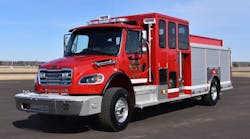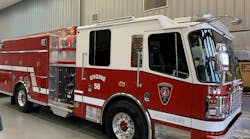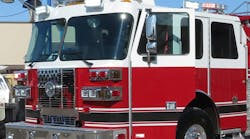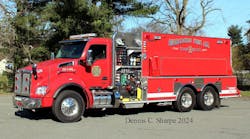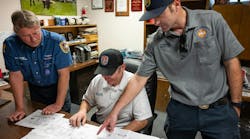I generally do not write about emergency vehicle response but because it is one of the larger causes of firefighter fatalities, I decided to incorporate this issue with my usual topic of technology.
Use the unit's Existing Technology
Red lights, sirens, traffic control devices (infrared, audible, traffic pre-emption controls)
All personnel fully seated and seat belted in position - VEHICLE DOES NOT MOVE UNTIL EVERYONE IS SEATED
Apparatus intercom system (for riding safety and hearing protection) - verbal confirmation everyone is ready and seat belted.
Use of mounted video cameras to provide visibility in blind spots and rear for backing. The use of a backup camera does not negate the use of spotters or guide persons.
Without technology...SOG's, driving standards, EVOC, driving evolutions, training/certification, and limited response speeds. The major contributing factor is Driving too fast, Driving too fast, Driving too fast. Either it is simply driving too fast, driving too fast for traffic conditions, driving too fast for road conditions, driving too fast through intersections, driving too fast for type of vehicle being driven, etc.
Simply divided into three general areas: Driver capabilities, vehicle design and operations.
Develop and Acquire New technology
Development of radar sensor technology to view and establish a 'circle of safety' around the apparatus - create a shield with audible warning and serve to prevent pedestrian accidents and vehicle collision in general.
Use of GPS or AVL and ties to Communications Center and CAD mapping - may avoid tragic collisions between emergency vehicles at intersections. With the new phase II wireless phones, GPS is a requirement. This will also maximize efficiency of emergency responders.
Develop audio vehicle navigation systems for emergency response vehicles to provide directions to incidents. This provides instructions directly to the driver and keeps his/her attention on driving.
Wide availability of emergency vehicle response simulators that can present any number of scenarios that can be used to safely make emergency drivers of the impending dangers during emergency response. This would allow drivers to experience situations too dangerous to create in a practical driving exercise.
Emergency Vehicle Early Warning Safety System (E-ViEWS) which is a first-of-its-kind preemption and warning mechanism. High-intensity light-emitting diode displays are positioned above the centers of intersections to inform motorists from which directions emergency vehicles are approaching.
Deployment of Intelligent Transportation Systems (ITS) which include controls that help to reroute traffic through transportation management centers, warn emergency operators of traffic congestion, warn emergency drivers of hazardous road/weather conditions.
Be persistent in working and developing technologies with manufacturers and the Department of Defense.
Technology Opportunities
The Robert C. Byrd Technology Transfer Center has expressed an interest in identifying emerging technologies with applications to the needs of the emergency response community and working with developers to commercialize these needs. The ERT program is currently looking for an Approaching Traffic Warning Device for Emergency Response Vehicles.
Collisions between emergency vehicles and other vehicles are common events. Many of these collisions occur at intersections. Public vehicles approaching at 90 degrees to the direction of travel of emergency vehicles are very difficult to see. Using sensors mounted on the emergency vehicle, or in a fixed location near the intersection, or both, could alert emergency vehicle drivers (and other motorists) of approaching traffic (cross traffic).
While this article focuses on the emergency response we must also consider all of the driving phases...
- Pre-response - insuring that the apparatus and equipment is ready and well maintained on a regular and documented basis. Vehicles are inspected and pass inspections.
- Preparing to respond - establishing the readiness and 'circle of safety' around the vehicle before departure.
- Response - Recognizing present road/weather conditions, time of day, time of year (school), use of all warning devices and traffic control devices
- Arriving at the scene - proper positioning of the apparatus for the situation.
- Departing the scene - re-establishing the readiness and 'circle of safety' around the vehicle before returning and insuring all persons are clear of the vehicle.
- Returning the unit to service - Visually inspect the apparatus and equipment to identify and repair anything that would impair vehicle driving and/or operations.
Some useful websites for reference:
- Emergency Vehicle Response
Emergency vehicle driver training, apparatus placement, scene safety, and apparatus design. Also help is provided at no charge to emergency vehicle operators who have wrecked and may want to talk to someone who has been there and done that. - Emergency Response Guidelines
- Emergency Response Apparatus Forum - A vast amount of resources and discussion from Firehouse.com's Forums
- Emergency Responder Institute & ResponderSafety.com.
Find out the latest information on emergency vehicle response along with a great deal of resources including a white paper on protecting emergency responders on highways and a free highway safety video. - NIOSH Reports - provides reports on firefighter fatalities involving emergency response (and others)
- Article Bibliography on Fire Apparatus Colors
- Fire Apparatus: Past and Present

